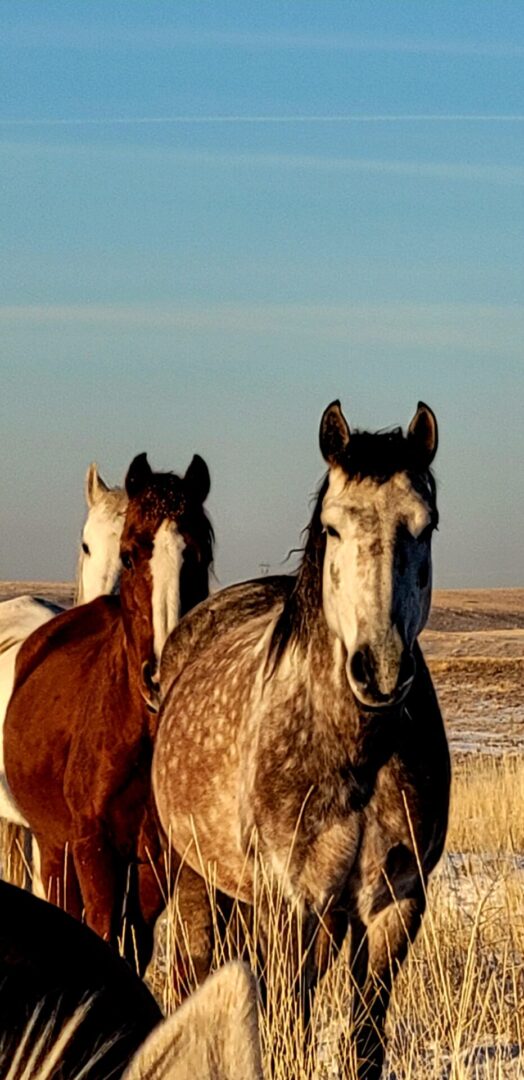
Bodywork | Healing Sessions
Each session is tailored to the specific needs of the horse and client. I usually start with a history of why you want me to work on your horse. Then, we look at movement, both for traditional lameness or performance issues and movement changes that can indicate a subclinical issue that affects performance, attitude, or future issues. We discuss what your expectations are for the horse. I also look at saddle fit and hoof balance and care.
I am a certified equine bodyworker, trained as an equine chiro, farrier, and certified equine and human kinesio tape practitioner. Throughout the years, I’ve also completed an equine massage course, a neuro-centered biomechanics course, and equine dissections and spent countless hours traveling down the rabbit holes of movement, proprioception, polyvagal responses, and pain management. My bodywork focuses’ mainly on myofascial release, nerve impingement therapy, and a physical approach to the horse that incorporates the ideas of myofascial meridians developed by Tom Myers and European vets. While technique, skills, training, and experience are foundationally important, They ultimately channel love as a healing energy that heals. It has been called laying on of hands, Qigong healing, or even Reiki, but it is the knowledge and wisdom of years of giving back to our horses that informs my hands and sessions. Her example has been a guiding light to help these sessions become more effective.
My understanding of a horse's mind and my horse training background goes back to riding with Tom Dorrance years ago. I wouldn’t presume to teach you to ride your discipline, but his ideas of how to approach and interact with horses pervade everything I do.
I am also a certified Qigong instructor in an ancient medical healing form of Qigong. This medical Qigong training helps me to listen to the body and have a ”conversation with the tissues.” So, these sessions freely flow between structural work, reprograming movements, energy work, and horse training.
Since I am a mobile practitioner living in North East Oregon, I am usually based in the Northwest US, Washington, Oregon, Idaho, Nevada, and California. But I also travel nationally and internationally when the need arises. If you are out of my usual area and would like to discuss sessions or evaluations, please reach out.
Clinics
Over the years, I have also done a variety of clinics on a custom basis.

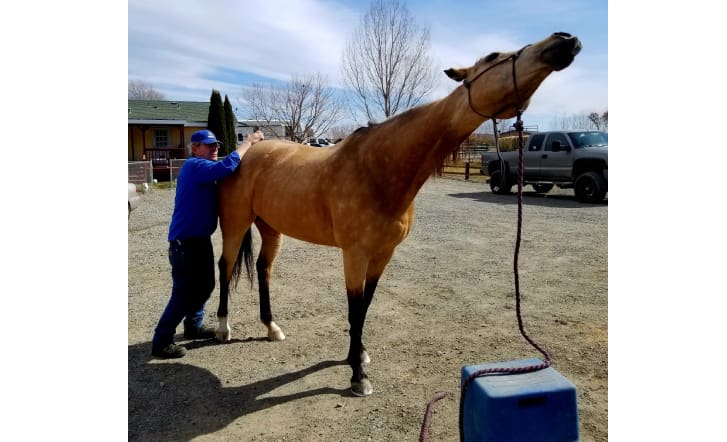

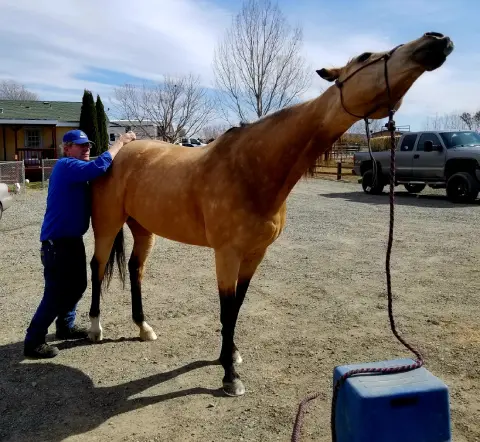
Body and Pain Assessment (We Call It a Pre-Prepurchase Clinic)
Most of us want a willing partner in our horses, but many of our horses exhibit some form of resistance. In my experience, a big factor in a horse's resistance is physical pain.
While it’s obvious that our horses are athletes, we seldom think about what they are asked to do on a daily basis. We ask them to walk, trot, canter, race, jump fences, spin around barrels, react to cows, and do a wide range of other athletic endeavors while carrying a rider. Riders who often only ride 7–8 hours per week are often not in peak physical shape and possibly even still learning to ride and train. And with many horses, it is after spending the last 22–48 hours locked in solitary confinement.
It’s no wonder our horses get aches and pains from their job. Many people don’t want to cause their horses pain, but are not aware of how to assess if their horses are sore. And if they are sore, what should they do about it? In the morning, we covered how to watch a horse and what to look for to assess if he or she is moving freely. We explore how to localize what is causing the pain and a few ideas about how to use massage, some groundwork, and under saddle exercises to alleviate the pain. We also look at saddle fit so that when we get on, the horse has the best possible chance of being able to physically fulfill our expectations.
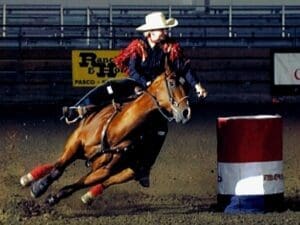
Conditioning Clinics
We can also do conditioning clinics using heart monitors to assess your horse's aerobic/anaerobic conditioning.
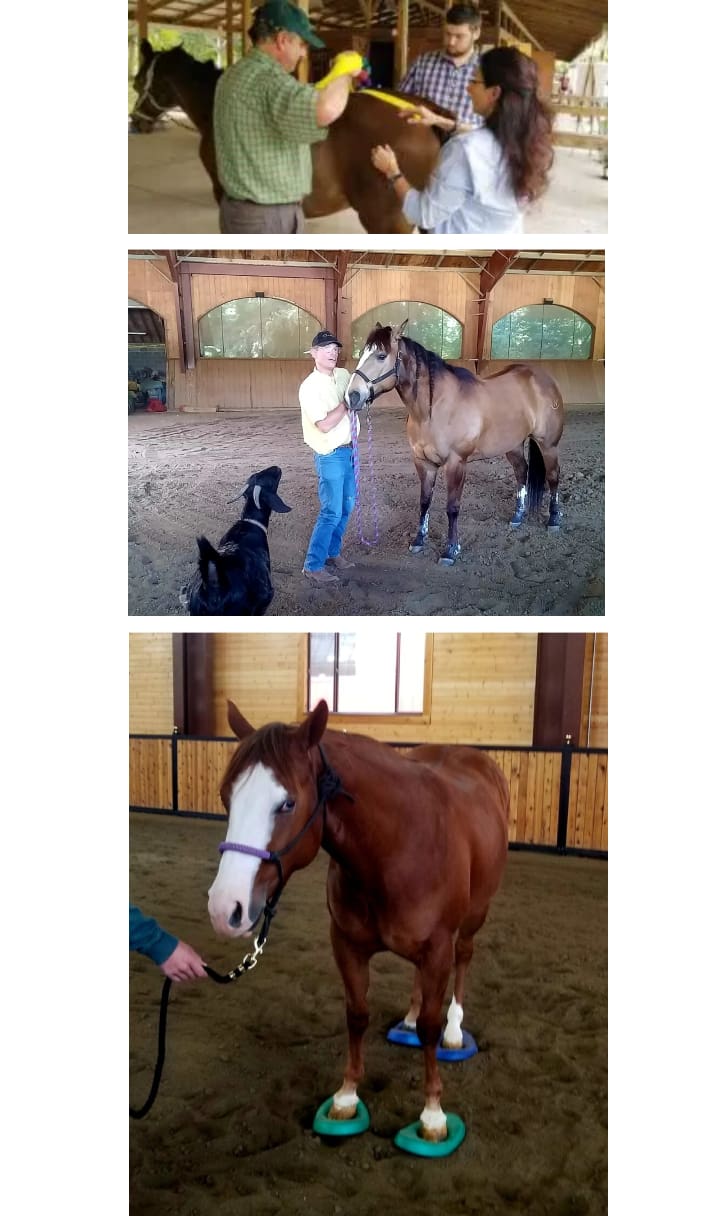

Kinesiotaping Clinic
Another popular clinic is our KinesioTape clinic, which introduces a kinetic style of taping. Kinesio tape is a light, stretchy tape that works on the nervous system to change the way the brain “sees” the area being taped. It is usually used to reduce pain, bring blood into an area, or support a tendon. You see it commonly as colored tape in unusual patterns on pro athletes. We teach you how to apply it and get it to stay on your horse. And teach you how to use it for both horse and rider. The unique approach to our clinic is that we show you how to use tape to repattern movement, including leg flights and gait irregularities. That’s why we call it a kinetic (movement) style of taping. It is amazing to help with pain and repatterning movements for both horses and riders.
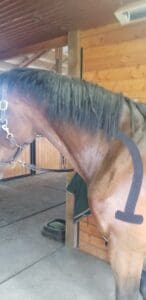
Neuromuscular Groundwork and Reiki Clinics
Neuromuscular groundwork is a quiet, gentle way to repattern your horse's proprioceptive system after an injury, during rehab, or just reorganize movements to make it more fluid and balanced. It was developed by Chris Hoffman as a way to change how your horse moves and how she thinks about being asked to move. It also has the effect of helping you and your horse regulate yourselves from a polyvagal approach. These terms will be explained, but the clinic is mainly focused on a visceral understanding of listening and communicating in a way that helps your horse's brain relax and move more easily. Chris also does Reiki clinics for horsemen that combine the energetic benefits of Reiki with in-saddle connection. She also will do attunements if the rider wants to go deeper into the healing paths of Reiki. Please contact us for more info.
If any of those are interesting, please contact me.
Rider Symmetry Training Clinics – Online or in Person
Ask yourself these three questions:
Do you put equal weight on your right and left stirrup?
In all three gaits, walk trot and canter?
How can you know?
Anyone who has ridden horses for any length of time or has just been athletic and active has gotten their share of bumps, bruises, and shocks. This is especially true for anyone with a history of car accidents, concussions, broken bones, or replaced joints. All of these events can affect how our bodies relate to gravity. In my experience working with riders in our clinics, presentations, and private sessions, most riders (even professionals) are between 5–25 pounds different between their left and right sides. Personally, I was 40 pounds different, which is what prompted the exploration that led to this course. Realizing how widespread this issue is, I wondered why this program was created. Most of my business is working or sore, lame, or asymmetric performance horses. For a horse that can feel the weight of a fly, 10–15 pounds is significant. It forces the horse to compensate for carrying us and causes movement and, eventually, joint issues. And when we think about our cues on a horse, if we are off from side to side, are we really giving the same cue to the left as the right? In terms of keeping a horse sound, it is vitally important to be even in the saddle, and for performance horses, the more even we are, the easier and faster they can do their job. Our bodies have three really powerful mechanisms to keep us upright and balanced. Let’s look at those mechanisms and how they interact to keep us upright.
Our bodies use three systems that all interact to keep us even and upright. The first and probably most important is our visual horizon. Scientists think that about 45-50% of our balance comes from the signals our eyes send to our brains about where the horizon is relative to our bodies. That’s why some people get vertigo and become seasick when the horizon and our bodies are constantly moving in different directions. This visual sense works well when things move slowly. But it doesn’t work quite as well at speed, especially if we are moving also. Barrel racers, polo players, and cowboys working steep ground are all affected by this. That’s why the body has another important system, the inner ear or vestibular system. Most people have heard that our inner ear is part of our balance system. For our purposes, the important parts are the semicircular canals. These canals are fluid-filled tubes oriented in three different planes and filled with very sensitive hair. They are connected to nerve fibers that are directly wired to the balance center of the brain. The hairs in the semicircular canals act like an accelerometer to instantly tell the brain how the head is oriented in space. We will get into this mechanism later in the program. The body sees the head as a very important factor in keeping upright. This accounts for about 35% of our balance. In the absence of our visual component, the inner ear takes over. You can try this for yourself by closing your eyes and seeing how it affects your moving balance. This sense is probably more developed in divers, gymnasts, vaulters and trick riders than in the average person.
The third sense involved in athletic or dynamic balance is the proprioceptive system. This is a network of stretch and pressure nerve endings throughout the body that sends signals directly to the brain. This network of nerve pathways is constantly telling the body where it is in time and space. It's estimated to be about 20% of our balance system. It is also vitally important for relaying what our body is doing relative to another body (like a horse). Anyone who’s ridden well realizes what we call feel, and our body’s response to a horse's movement happens without our thinking about it. If we have to consciously think about a movement, we are usually a step behind it. Proprioception is the automatic response that we use in riding.
These three systems, visual, vestibular, and proprioception, are so important to the body that the brain listens for coherence between all three. As long as all three are sending a similar signal to the brain, everything functions normally. But if the different systems are sending different signals about where the body is, the brain raises a red flag, and it affects your balance and posture. Yes, your posture! Our posture is affected subconsciously by our muscle tone, which is a function of the motor nerves activating muscles differentially. Many things affect those signals or how the brain sees those signals, such as pain, habit, emotions, tension, etc. The bottom line is, our sense of balance changes our posture to make our bodies as comfortable and functional as possible in the position we spend the most time in. The problem comes when functionally comfortable at rest is not always what we need in an athletic pursuit. Most of us have had the experience of being told (or telling a student) to put more weight on one foot, lean back, or sit to one side. We are able to consciously do it, at least until we have to think of something else. Then, we revert back to our postural default. That’s where this program is so effective. It changes these balance and posture issues at a subconscious level. It helps to straighten us and our horses while we are thinking about something else. As little as 10 minutes twice a day can make a huge difference in 4–6 weeks. If we combine these exercises with a program of kinetic k-taping to speed up the changes, we can make huge strides fairly quickly. This program doesn’t teach you to ride your horse. It just gives you a huge advantage by allowing your body to do what it already knows how to do more clearly and with less noise and compensation. Contact us to book an assessment training, either in person or by Zoom.
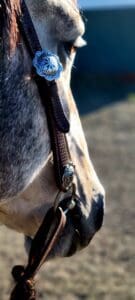
Hosting Clinics
If you are interested in hosting a clinic, contact me, and we can discuss logistics, particulars, and ways to customize the clinic to fit your needs.
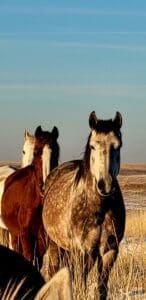
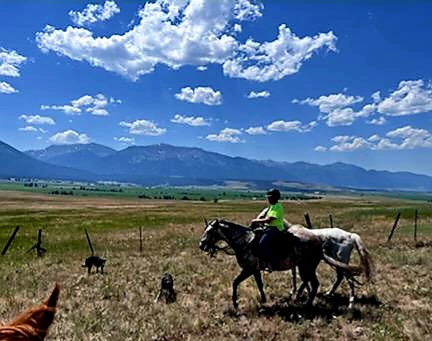
Retreats - The Soul of a Horse
Have you ever seen your horse standing in its stall waiting for someone to come by? Or wondered what it was thinking?
When you first were getting involved with horses, either as a child or an adult, did you have visions of riding that involved freedom, connection, and joy? Could you imagine the feelings of joy, freedom, and power of galloping through a meadow with your partner and friend? Most of the young children I watch naturally approach a horse innocently like this before they learn to control their horse or stay safe and make them perform. They are slowly taught that horses are unpredictable and that to be safe, they need to be in control, to be the lead mare, without ever really knowing what that actually means to the horse. We are taught to ask, tell, or command far more often than we are taught to listen. Even when we want to truly connect or listen deeply, we often realize that we don’t have the language to speak or listen to the horse. Human language is made of words, while a horse’s language is movement, facial tension, touch, body language, and silence. When we try to translate our words and concepts into something that makes sense to a horse, it often sounds like high school language class where we repeat simplistic rote phrases back and forth. But if just being able to order food and find a bus isn’t enough, we need fluency. If you want a deep, meaningful, heartfelt conversation with someone from another country, you have to learn their language. How much more so for a being from another species?
We have all been in a lesson with a” professional” pushing you to do something with your horse that you weren’t comfortable with. Maybe she didn’t feel like she understood the command or that you weren’t sitting correctly, but you were told the horse needed a correction because she was being naughty and “not paying attention.” At the end of your ride, your horse looks at you, and there is a gulf. You’re not really sure what is missing, but your intuition tells you there is something else that you just aren’t seeing. So you try to be kind and sweet between lessons, buy the best equipment, and bring the best treats, but it still doesn’t bridge that divide. These retreats were designed to help you start to find that language to feel a new way of being with horses, being with the land that shapes so much of them, and being with each other that starts to create those bridges.
Lots of us have ideas about what a “wild horse” means to us, whether physically, emotionally, or spiritually. But the horses we see every day aren't wild, free beings running with their herd, acting from the expression of their ancestral knowledge and power. Most often, they are an incarcerated population. The way we usually keep horses is an expression of convenience for us. In our busy lives, we want our horses to be easy to catch, so we keep them in stalls (solitary confinement, especially if they are expensive) and paddocks. We want them primarily clean, so we buy the best blankets, rugs, and slinky and look athletic. We restrict their diet to high-quality feedings 3 or 4 times in a 24-hour period. That is the opposite of how they evolved and have lived for the last few thousand years. And in order to make that all work, we mostly forget to actually listen to our horses. If we do try, we usually only listen to the part we want to hear, the part that pleases us, or we totally misinterpret what they say to make it more palatable to ourselves because we are not able to speak a common language.
As esoteric as this sounds, we are not trying to abolish the competitive or recreational horse world. And we are not here to teach you how to ride your discipline. What we are here to do is help you create a space with your horse based on a clarity driven by whom the horse actually is, a fluency of communication, and a heart connection that allows both of you to excel in whatever discipline you ride.
The Soul of the Horse retreats will help us learn to actually see the horse as she is. It is not how we want to see her but how she actually is when she is free to choose, powerful in her ancestral wisdom, and safe with her herd. To do that, we have to allow the horse to teach us in their language. A language that is not verbal and requires their freedom to express themselves. A horse lives in the present, and the way she teaches best is through embodied experience. It’s an experiential way of being, but it’s not something that can be expressed in concepts or words. It’s a language that has to be experienced, felt, and responded to in their world, not ours. Consequently, most of the work in this retreat will be on ourselves. We will be in the horse’s classroom, the meadows, and the rolling forests of the Wallowa Valley. These are the plains and canyons where the horse evolved eons ago and recently returned. It’s a land that knows the soul of a horse. One of the tenets of this retreat is to know the horse. One must also know the land that the horse calls home. In this retreat, we will explore ways to listen to the horse, the land, and each other (they are very similar). The horses that we will interact with are all experienced outfitter horses, savvy to people but also who spend much free time in a cohesive, free-range herd. Using touch, bodywork for ourselves and horses, training theory, polyvagal training ideas, body language, listening, breathing, meditation, and silence, we will start to unravel the words and stories in our heads and start to feel the horse as she truly is. And possibly start to reach across that interspecies chasm. To really SEE the horse as the horse sees itself, and to see yourself as the horse sees you.
These retreats are usually privately booked. We will set up lodging and accommodations in Northeast Oregon and use our horses. You just have to bring your group and an attitude of seeing and touching with open eyes and hearts. Contact me to discuss this further.
